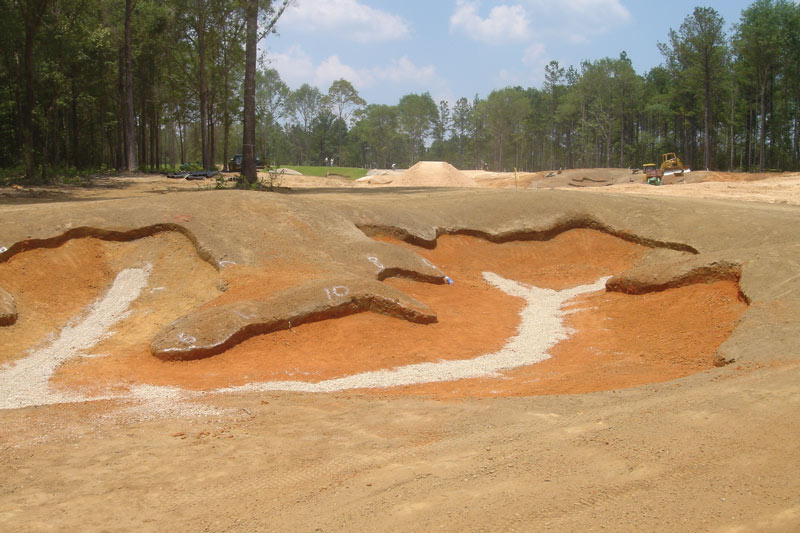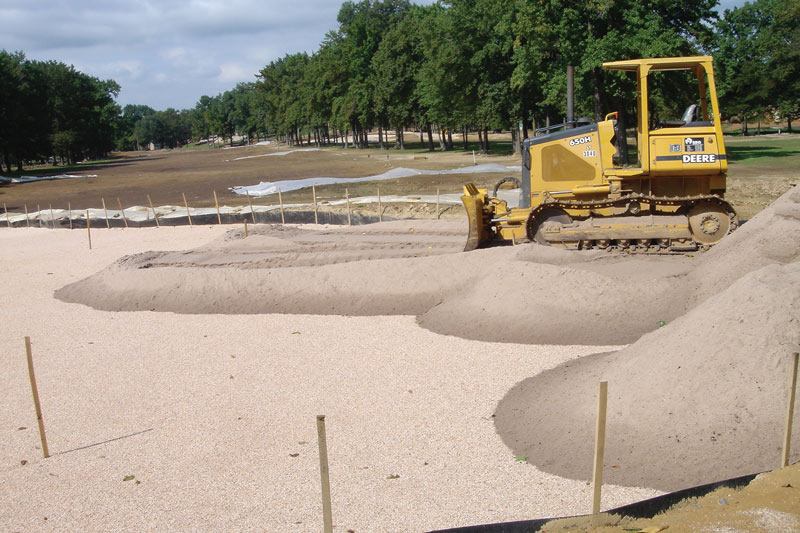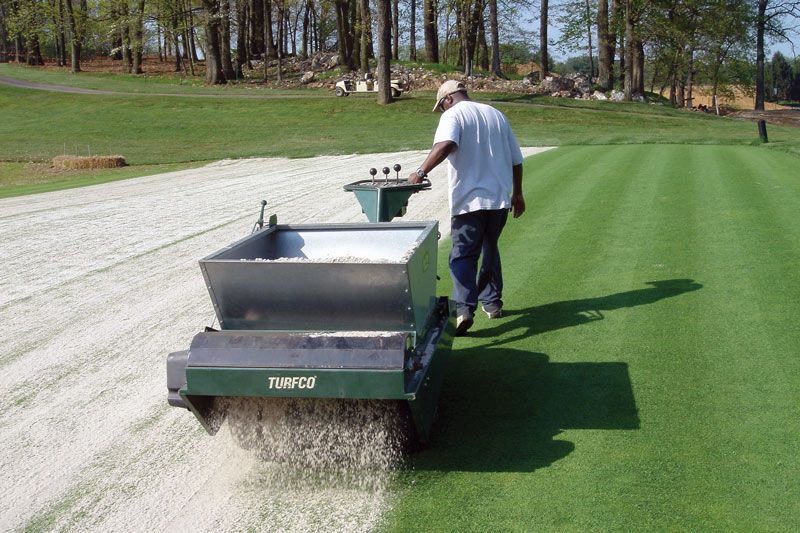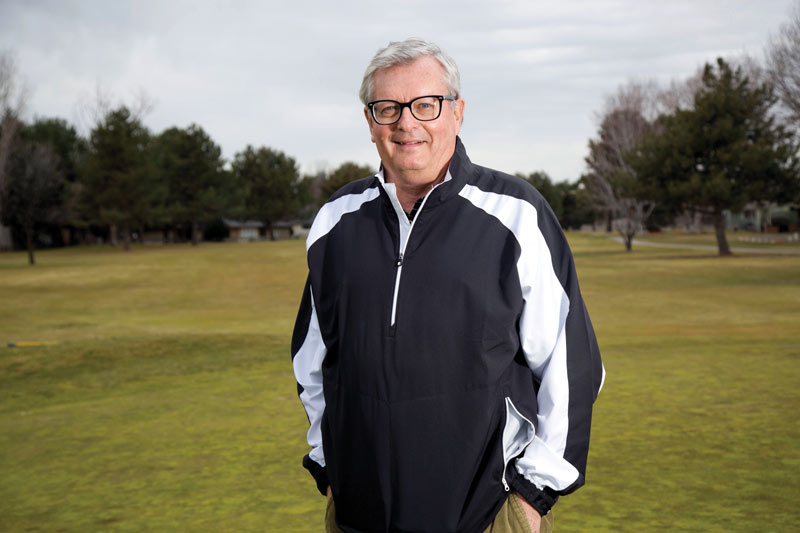
Bunkers are the most frequently restored, renovated, upgraded and enhanced part of golf course infrastructure, not only because they wear out relatively quickly, but because the conditioning of bunkers gets the spotlight most often in modern golf. Shown here, bunker construction at Fallen Oak Golf Club at Beau Rivage Resort and Casino in Biloxi, Miss. Photos courtesy of Terry Buchen
At many facilities, enhancements to the physical portions of the golf course have been tabled since the 2008 financial crisis, with capital improvement budgets significantly slashed or even eliminated in the aftermath. With the economy finally bouncing back, course officials have begun loosening their grip when it comes to previously planned infrastructure work. Golf course superintendents, architects, green committee chairs, general managers, owners and other decision-makers must do their research to appropriately budget for what will need to be fixed, improved or upgraded. This important due-diligence process involves completely evaluating the quality of every course component, from the greens, tees and fairways to the bridges, tunnels and retaining walls. Establishing a regularly updated, long-range master plan along with an infrastructure assessment and business plan, prepared with the expertise of a golf course architect, should be a top priority at every facility.
As a third-generation superintendent and agronomist with more than 50 years of experience, I’ve become familiar with the life spans of golf course infrastructure, and have advised on upward of 175 new, restoration, renovation or replacement projects on courses across the country. Infrastructure life expectancy varies depending on climatic zone, the component’s age, the quality of the original construction, previous enhancements, maintenance practices, budget and overall playing condition standards. The golf course infrastructure life expectancies chart shows my estimations for the longevity of the major course elements, and the following text delves into some of the influencing factors and best infrastructure-focused practices for superintendents.
Greens and collars
In all three climatic zones, greens and collars should have their performance checked at least every seven to 10 years by sending undisturbed core samples of the entire green’s profile to an accredited physical soil testing laboratory. This holds true regardless of how the greens and collars were originally constructed or how they’ve been maintained. This thorough testing determines how well the physical characteristics have stood the test of time, and consists of a complete physical soil analysis of the top 3 inches, top 6 to 9 inches, and then the remaining portions of the green’s profile. It also examines organic matter content; topdressing accumulation and quality; sand, silt, clay and gravel particle content; sand sieve sizes and sand fractions; pH; particle density; bulk density; infiltration rate; and aeration, capillary and total porosity. The lab’s inspection will also reveal whether an excess accumulation of organic matter is increasing the water-holding capacity and decreasing the infiltration rate in the top portion of the green’s surface, and whether this accumulation should be dealt with during routine maintenance practices or by stripping and removing. Additional insights include whether sand particle size and shape have changed; whether the upper topdressing layers are compatible with the original sand-based greens mix materials; and whether the drainage gravel has broken down prematurely.
A relatively new phenomenon showing up on sand-based greens mixes is the formation of “iron precipitate,” usually at the interface of the greens mix with the drainage gravel layer (though it can form in other parts of the mix below the organic matter layer), where it can impede the subsurface drainage of the green if it becomes hard and dense. The undisturbed core samples testing usually looks for this potential condition and makes recommendations for its eradication.
USGA, California and other sand-based greens can last a very long time if their physical characteristics and performance continue to be satisfactory. Bermudagrass and seashore paspalum greens, which are usually prolific thatch/organic matter producers, are usually stripped, have the excessive thatch/organic matter removed and replaced with greens mix, are fumigated, and are regrassed approximately every eight to 12 years. Creeping bentgrass/Poa annua greens in the transition zone and cool-season regions obviously do not produce as much thatch/organic matter as their warm-season counterparts, but should also be stripped and regrassed as required. (Methyl bromide soil fumigant is no longer available for use on golf courses, but Basamid and other alternatives currently being tested are acceptable for use.)

Greens construction typically follows the specifications laid out in the USGA’s “Recommendations for a Method of Putting Green Construction” or the University of California Cooperative Extension’s “The Sand Putting Green: Construction and Management.”
Push-up greens can also last quite a long time, but these often require restoration or renovations throughout their lifetime to maintain or boost their performance, such as sand-channel drainage piping, DryJect sand injection, installation of smile drains, drill-and-fill aerification, or deep-tine aerification. They require regrassing on a similar timetable to sand-based greens.
Another advantage of regrassing in any climatic zone is to reap the benefits of newer turfgrass varieties that offer improved green speeds, hole location considerations, firmness, aesthetics and other perks. Before making the important (and sometimes difficult) decision on the best turf type and variety, trial these newer varieties in an on-site turfgrass nursery, by observing university turfgrass test plots, or by consulting the turfgrass testing results available on the National Turfgrass Evaluation Program website. Some venues select turfgrasses based on which turf types and varieties have already proved successful on other courses in the vicinity.
The contours and elevations of the surface of greens will change over the years from frequent sand-based topdressing and greenside bunker sand accumulation, no matter the type of initial green construction. Cupping locations can become limited, resulting in more concentrated foot traffic and less playability variety. Greens sometimes shrink over the years despite best-laid plans, because any time an edge is mowed, the putting surface’s size invariably gets reduced (particularly if the mower is a triplex greens mower). Superintendents and architects should work together to restore the surfaces to where they were or should be as promptly as possible.
Tees
Sand-based and push-up tees are the most common in all three climatic zones. Sand-based tees may also have subsurface piping and drainage gravel. Push-up tees should be improved each year via frequent topdressing with a sand-based material. Tees can become unlevel over time, and should be stripped, have their tee soil mix replaced, be laser-leveled, fumigated, and regrassed as needed. (While more common in the warm-season regions, this is also carried out in the other climatic zones, though sometimes less frequently.) Tees should be enlarged (or new tees added because of changes in club and ball technology) and subsurface piping and drainage gravel added as needed too. New grass types and varieties can also be introduced during this process. Basamid or its equivalent should be used as necessary. Course officials should collaborate with architects for continuity of the overall tee design and playability concept.
Fairways, approaches and collection areas
Regrassing is becoming more common to replace contaminated or outdated turfgrass. If the topsoil needs improvement, sand capping can be added, but do so after having a “moisture-release curve” test done as part of the physical soil test. This optional but invaluable test will do away with any guesswork by telling you exactly how deep the sand cap needs to be for proper drainage. With the lower mowing heights golfers are now enjoying on approaches, placing a sand cap and drainage piping where required is being done more frequently to make these areas firm and fast. If a sand cap cannot be installed because of disruption of play or the overall cost, superintendents can develop a frequent, annual sand topdressing program to improve the soils and drainage and create firmer playing conditions — and this should be done routinely even if a sand cap is installed. Basamid or its equivalent should be applied on existing topsoil and sand caps as required.

Newly installed turfgrass should have a dedicated maintenance budget allocated for its grow-in phase, apart from the routine maintenance operating budget.
Maintained roughs
Maintained roughs are usually regrassed in conjunction with fairway regrassing. Cool-season grass courses often kill their existing turf, thoroughly renovate it, and then seed with new “proven winner” turfgrass types and varieties, ideally in fall. Basamid or its equivalent should be applied as necessary when the budget allows.
Intermediate roughs
In warm-season regions, intermediate roughs merit regrassing when the turf becomes segregated, mutated or contaminated (or simply when a change in turf type is desired). Contaminated cool-season grasses should be stripped and solid-sodded with low-mow turf types and varieties that have a good color contrast with the surrounding greens, fairways, approaches and maintained roughs. Basamid or its equivalent should be applied as needed.
Native roughs and natural areas
Native roughs in the cool-season and transition zone regions should be reseeded as needed or totally renovated as the vegetation wears out with age. Native grasses should be mowed down in spring or fall, and controlled burning is also an option where permitted. In warm-season regions, natural vegetation will become overgrown and must be thinned out and eventually replaced.
Bunkers
Bunkers usually wear out faster than any other part of golf course infrastructure. Contamination from silt, clay and gravel from the native subsoil beneath the bunkers and from the edges/lips is typically what spurs the replacement of bunker sand or an upgrade to a better-quality, tested and approved sand. Great strides have been made in geotextile bunker liners, porous concrete/polymers, sprayable soil-binding materials and other products that stabilize the bunker faces, slopes and bottoms to virtually eliminate bunker sand contamination and erosion issues.
Too much bunker sand accumulation from adding sand for many years — rather than replacing it — is also a valid reason to completely replenish the sand. Sand depths of 2 settled inches on the slopes and 4 settled inches on the bottoms are the accepted standards for men’s and women’s amateur and professional tournaments and championships. Bunker sand normally takes 90 days to settle properly, and if the sand must be shoveled or pushed back up the slopes following significant rainfall, the 90-day period starts all over again.
Superintendents can enlist an accredited physical soil testing laboratory to perform bunker sand suitability testing to determine the quality and playability of any sands being considered. Architects recommend trying out different sands simultaneously (along with bunker lining materials) in a test bunker. Bunker face irrigation should be added as needed to keep sand moist for better playing conditions.
During bunker work, drainage piping is also commonly cleaned out or replaced, and tested and approved greens-quality drainage gravel is installed or replaced. Flushing out drainage piping and installing tracer wires to help easily locate the pipes are becoming popular practices.
Bunker sand accumulation on top of the turf facing the green raises the bunker slopes, green’s surface and the surrounds, which alters the original design concept. Routine edging of bunkers also changes the shape and contours as time goes on, despite best-laid plans. Architects often take the opportunity to restore bunkers to their original design concept or refresh them as they see fit when the interiors of the bunkers and surrounds need to be renovated. Fourteen-gauge tracer wires have become a popular means to identify the original architectural design of bunker edges. A wire locator finds the lips around each bunker, making routine edging easier.
Irrigation system
Aboveground irrigation equipment — such as sprinkler heads, quick coupler valves, swing joints, field satellites, the master computer controller, pump stations, and fertigation/injector systems (as well as their underground wiring) — requires total replacement most often in all three climates. Courses can use this shorter life expectancy as an opportunity to take advantage of new, higher-tech irrigation equipment for more efficient water application.
Newer HDPE piping and fittings last significantly longer than PVC, but do have a higher replacement cost. The current trend is to use HDPE pipe and fittings if the budget will allow. These require less routine maintenance and easily pay for themselves in the long run. Gate valves, isolation valves and other fittings usually get replaced when the pipes do, but sometimes require it sooner. As irrigation water supplies continue to dwindle, an understanding of the facility’s overall water rights and the use of new irrigation wells, recycled effluent water and other alternative sources is critical for its long-term viability.
Drainage
In agronomy school, we often learn that drainage, drainage and more drainage is a top — if not the top — priority in growing quality turfgrass and providing exceptional playing conditions. Whether a course is 1 or 100 years old, drainage work is usually required annually, forever. It’s quite common for courses to budget to add more drainage every year. Larger projects on many portions of the infrastructure to replace or add drainage piping, fittings, grates, etc., can sometimes draw from capital expenditure funds instead of going on the operating budget. Grading and reshaping can also be a viable option for better surface drainage in addition to or in lieu of adding subsurface drainage piping.
Cart paths
Asphalt or concrete cart paths and their respective base materials should usually be replaced after they first become cracked, their edges slough off, or they heave above grade from freezing/thawing. Both types of surfaces should be routinely “sealed” as part of the maintenance operating budget, which will extend their useful life. Contact with the surrounding turf’s irrigation lowers the life expectancy of both surface materials.
Coquina shell, decomposed granite and other gravel-type materials typically have a lower installation/replacement cost, but they merit more routine maintenance to smooth them out after rainfall, winter freezing and thawing, and other events. Course officials sometimes elect to use the existing gravel-type cart paths as the base material and then surface them with asphalt (more cost-efficient) or concrete (more durable but pricier). Tree roots are another contributor to premature cart path deterioration, as they can cause cracking, rising or lowering, making for a bumpy ride in carts and maintenance equipment.
Tinting the concrete with dye is becoming more popular in warm-season regions and is done occasionally in the other climatic zones. (Pigment should be added at the concrete plant so it has ample time to mix in during the travel time to the venue.) Cart paths and curbing adjacent to greens and tees can effectively divert and control surface water as part of a course’s overall drainage goals.
Lakes
Lakes in all three climatic regions usually require dredging, especially if the irrigation water source contains sand, silt or clay, which will accumulate on the bottom over time and reduce the amount of water storage. With water shortages and increased water costs, having full-capacity water storage is vital to a course’s overall success.

Author Terry Buchen, CGCS Retired, MG, has advised on upward of 175 new, restoration, renovation or replacement projects on golf courses throughout the United States.
Dredging properly without damaging lake liners is difficult. Lake liners are often used where the base soils will not seal the bottoms to contain the water adequately. Liners must be replaced more frequently, especially on exposed areas along the lake edges where sunlight degradation occurs. Lake edges require regrading and re-vegetating, especially if boring animals disturb the original contours/elevations and aesthetic value.
Bridges
Superintendents should have bridges inspected by a qualified engineer on a regular basis to ensure the safety of golfers and course employees. Wooden bridges usually have a good life expectancy, and applying a waterproofing material may help preserve them even longer. The wooden surface of a bridge obviously has the most vehicular and foot traffic and should be replaced as required, whereas the other parts of the bridge will hold their structural integrity longer.
Bulkheading/retaining walls
Bulkheading and retaining walls are usually quite durable and long-lasting, depending on their construction materials, but they should still be inspected as needed. Changes in aesthetic appeal tend to be just as important as structural integrity considerations in deciding to replace these structures.
Tunnels
A qualified engineer should thoroughly check tunnels annually for structural stability and safety, regardless of whether they’re made of concrete, corrugated metal pipe, cinder/building blocks or another material. Drainage sump pumps, drainage grates, lighting fixtures, safety mirrors, subsurface piping on both ends of a tunnel where the cart path enters and exits, and the cart path surfaces covered by the tunnel should be replaced as required.
Pine straw/wood mulch
Warm-season courses that use pine straw or wood mulch usually replace it at least once or twice per year. Venues that cannot afford that frequency sometimes opt to paint the existing mulch materials to make them appear new.
Driving range
Practice tees should have a sand cap or other soil-improving structure added and be laser-leveled, enlarged, fumigated and regrassed as needed. Practice tees should have a minimum of 1 surface acre for each 18 holes. Target greens and practice fairways get continual traffic from the ball-picking machine and should be regrassed as required. Target bunkers should be renovated with firm bunker sand or a visually similar, highly firm material.
Short game practice area
Short game practice areas are in vogue, and many existing courses are building them — if they have the space — to stay competitive in the marketplace. These areas usually require restoration or renovation on a schedule similar to that of the regulation course. Practice bunkers require more frequent renovation, however, because their shapes and elevations shift rapidly from heavy use. The same is true of chipping greens, where bunker sand accumulates on the putting surfaces and bunker surrounds, noticeably altering the original design.
Terry’s top takeaways
- Establishing a regularly updated, long-range master plan along with an infrastructure assessment and business plan, prepared with the expertise of a golf course architect, should be a top priority at every facility.
- Of all golf course infrastructure, bunkers are the most frequently restored, renovated, upgraded and enhanced, not only because they wear out relatively quickly, but because their conditioning standards are those most discussed and debated among golfers today.
- Regrassing with newer, “proven winner” turfgrass types and varieties is becoming more popular for all primary playing surfaces for improved agronomy, firmer and faster playing conditions, and heightened aesthetic appeal.
- Green speeds will be a top priority of golfers for the foreseeable future. Superintendents and architects are employing newer, “proven winner” turfgrass types and varieties to keep the clientele happy in this regard.
- For tees, enlarging, removing excessive organic matter, adding sand caps and drainage, laser-leveling, regrassing, and also adding totally new teeing grounds is a popular design and playability concept.
- For fairways, approaches and collection areas, regrassing to remove contaminated or outdated turfgrass technology, adding sand caps and drainage piping as required, and stripping and removing excess organic matter coupled with a regular, routine sand topdressing program is a popular regimen.
- Aboveground irrigation equipment requires total replacement most often in all three climates.
- Drainage, drainage and more drainage is a top — if not the top — priority in growing quality turfgrass and providing exceptional playing conditions. Whether a course is 1 or 100 years old, drainage work is usually required annually. Larger drainage projects should be put on the capital improvement budget. Grading and reshaping can also be a viable option for better surface drainage in addition to or in lieu of adding subsurface drainage piping.
- Cart paths should be replaced after they first become cracked, their edges slough off, they heave above grade from freezing/thawing, or they’re damaged by tree roots.
- Driving range tees are the most frequently renovated facet of practice areas. Practice tees should have a minimum size of 1 surface acre for each 18 holes.
- Short game practice areas are in vogue, and many existing courses are building them — if they have the space — to stay competitive in the marketplace. New courses are constructing them simultaneously with the regulation course and driving range.
Terry Buchen, CGCS Retired, MG, is president of and consulting agronomist for Golf Agronomy International, based in Williamsburg, Va. He graduated from Penn State University’s two-year turfgrass management program, and earned a golf and park facility administration certificate from the University of California, Irvine. He is a Master Greenkeeper — one of only 72 in the world — a designation awarded by the British and International Golf Greenkeepers Association. Buchen was an agronomist and advance tournament official for the PGA Tour, setting up all 47 tournaments on the regular tour. He has been a Certified Golf Course Superintendent since 1978, and is a 49-year Life Member of GCSAA. He lives in Eagle, Idaho, with his wife, Debbie.